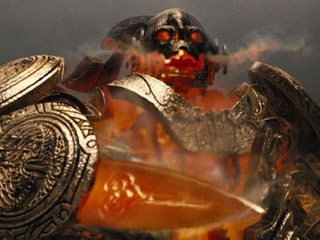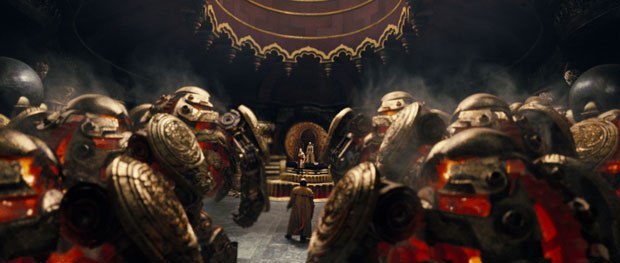Double Negative animator Jay Davis tells Ellen Wolff about the inner workings -- glowing cogs and all -- of Hellboy II's Golden Army.
Writer/director Guillermo del Toro is known for imagining eye-catching characters in Hellboy and Pan's Labyrinth, and he lives up to that reputation with his regiments of battling robots in Universal Pictures' Hellboy II: The Golden Army. Jay Davis was the lead animator on the signature "Golden Army" sequence that features those robots, moving from L.A. to London for a year to work at Double Negative on this film.
"The Golden Army sequence is chock full of complex animation and some pretty stunning visual craziness," says Davis. "I don't want to spoil anything," he adds, choosing his words carefully so as not to reveal plot points. "These robots are 12-feet-tall and made out of metal and have mandibles like an insect but no facial features, so all the character work had to be pantomime. They also had glowing cogs inside -- small bits of nanotechnology -- that were their inner workings. They were hard characters to animate because of that."
While the robot army includes thousands of individuals, Davis notes that low-res behaviors for the epic 'cast of thousands' were animated on cards. The primary focus for his computer animation team was on the roughly 30 hero robots that interact with Hellboy (Ron Perlman). Fortunately, Davis was brought onto the project early enough by DNeg Animation Supervisor Eamonn Butler so that he could witness the shooting of the Golden Army sequence plate photography in Budapest. (Davis, who spent 12 years as a Disney animator on such films as Meet the Robinsons and Hunchback of Notre Dame, had previously worked with Butler on Disney's Dinosaur.)
Davis was happy to have watched del Toro on set directing the action in which DNeg's CG robots would be integrated. "On set we had cardboard cutouts so the actors could see how big these robots were. There were no animatronics, so it was really important to have those cutouts on set. Some of the shots were over-the-shoulder of a robot looking down at Hellboy, or Hellboy looking up at a robot. We had to get the eyelines correct."
"There were also guys in green suits and scaffolding for the stunt guys to jump onto," Davis continues. "Hellboy jumps from robot to robot and smashes them or shoots them in the head. It was tricky because the scaffolding was static. We had to animate the robots so they didn't look static, so that Hellboy looked like he was standing on them. There's a scene where Hellboy lifts up the chin of a robot and shoots down its neck. On set there was a practical prop, roughly the size and shape of the head, painted green. Hellboy lifts it up and shoots down it, so the matchmoving had to be really tight."
But the challenge of integrating robots into plate photography only accounted for about half of DNeg's animation assignment. "There are some really long all-CG shots," says Davis. "The shots with plates were actually easier." To choreograph their shots, DNeg animators did three rounds of Maya 3D previs that included digital doubles of the main actors in the sequence, as well as the robots. "While Guillermo was shooting in Budapest, Eamonn was working with the animators doing previs. Guillermo shot the film in sequence, which was a slow way to do it, but that insured that the continuity worked. He had in his head what he wanted to do, and he did it. He also ended up using a lot of the previs stuff that we had done."

After shooting was finished in Budapest, del Toro remained very hands-on during the animation phase in London. Davis recalls, "Guillermo was there for our dailies. He's a fan of animation and he understands it, so it was great to get his direct feedback. If we hadn't had that kind of arrangement, I don't think we could have gotten this done in the time frame we had. It really is an animated film."
Davis' DNeg crew for The Golden Army sequence numbered around 16 Maya animators. "The biggest problem was the amount of work -- dozens and dozens of shots -- that we had to do in basically four months' time. The majority of the shots were bears to animate. We did a lot of re-casting of shots among the animators. I would cast a shot to an animator and if it wasn't going anywhere I'd move it to another animator to take a fresh look at it, so that the work didn't get too precious. You can get locked into an idea if it's your shot, but we didn't have the luxury of taking our time. Moving the shots around was the way to keep it fresh and get it done."
Knowing the special skills of the DNeg animators was key to getting the job done, and Davis cites as an example how animator David Lowry was especially good at capturing the weight that a 12-foot-tall metal robot would have. "David had animated Grawp the Giant in the Harry Potter and the Order of the Phoenix so he had a really good sense of how to get weight into a character. If the weight wasn't working in a robot's performance I could give it to Dave for a day and he could do magic. He was on the Golden Army sequence early on and did a lot to help define how these robots moved."
From his own experience animating on Dinosaur, Davis is keenly aware of the challenges of creating believable heft for large characters. "You have to have a strong pose and animate it so that it looks like the character's weight is positioned over its leg and swinging in a certain fashion. There's no simple button for 'weight!'"
This was especially crucial for these robots, which del Toro had designed to have their top halves be able to twist 360-degrees. Davis notes, "You have to think about how the robot's weight will resolve itself when it comes to a stop. There is torque and inertia. Our added level of complexity was torque."
A lot of troubleshooting was required for modeling, rigging and animating these robots, recalls Davis. "The rig that we animated with was pretty complex; not like a human rig. There were a lot of specific, machine-like movements required to get it to look robotic and able to move well enough to get the performance that Guillermo wanted." Fortunately, Davis was able to find some inspiration on his morning journey to work at Double Negative's studios in the Soho section of London. "It's across from Chinatown, and luckily they were tearing the roads up there, so on the way to work I could watch the big machines. They had a lot of high-tension, stiff joints. When they made a sudden stop, I could see how the force resolved itself within the machine."
The DNeg animators also looked at references on robotic arms, noticing how when they stop after completing a movement, there's a bit of oscillation as it comes to a stop. "We animated a lot with FK -- forward kinematics -- and not inverse kinematics," explains Davis. "IK would tend to give a lot of movement in the elbow, like a puppet, which makes the arm look a little weaker. We wanted the elbow joint to be stiff, and the secondary animation -- the resolution -- would be in the shoulder, not in the elbow. We were trying NOT to make these robots look like guys in suits."
Perhaps the most challenging aspect of robot animation was dealing with all the complex gears that make the robots tick. DNeg used a procedural approach, attaching the gears inside the robots to limb movements and body actions. "You'd raise an arm and it would cause the gears to rotate in a certain way," Davis explains. "If the robots were climbing stairs, that would set off other gears.
There were lots of levels of complexity. For some close-ups, like where you need to see the articulation of an arm, you can see all the mechanisms exposed. If we had the gears turned on while we were animating, things would slow to a screeching crawl!"
"Also their forearms -- as well as their torsos -- could spin 360 degrees, and there's a lot of eccentric movements in that. They have interesting ways of turning around and walking backward. It was a trick to make these robots not look flimsy or poorly made, even through Hellboy is still able to do damage to them."
And damage is to be expected in a Hellboy film. "Guillermo wanted to see lots of crazy things happen in The Golden Army sequence, like a disembodied head crawling around," recalls Davis. "I was a supervising animator for Doris The Hat in Meet the Robinsons and it was kind of similar to Guillermo's crawling head!"
As The Golden Army battle raged on, Davis' team had to animate these robots breaking down and then reassembling as they scrambled to revive their parts damaged by combat. "There's a sequence of long, complex shots where you get to see how these parts come together. That is some of the most visually gratifying stuff because you get to see them fight, and get destroyed and then reassemble. The shots where the robots are rebuilding were animated by Stafford Lawrence. It was like a junk heap coming together," Davis laughs.
The comedic side of Hellboy II is part of its charm, believes Davis. "This movie is chock full of crazy characters. It reminded me of the Cantina sequence in Star Wars. And the final film really moves. Every bit of our animation was used. When I've worked on other films, entire sequences would be cut, but this was so tight. These shots had lots of handles, and they were used, too!"
Ellen Wolff is a southern California-based writer whose articles have appeared in other publications, including Daily Variety, Millimeter, Animation Magazine, Video Systems and the website CreativePlanet.com. Her areas of special interest are computer animation and digital visual effects.










